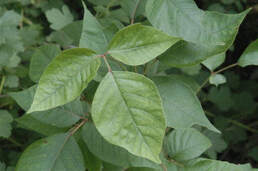
In the vining habit, aerial roots give the vines a fuzzy, rope-like appearance. As a groundcover, poison ivy is often confused with Virginia creeper or Woodbine. Poison ivy shrubs can appear in fields, pastures, woods or even the home garden. Leaf margins may be toothed, incised, lobed or smooth, but will always appear in groups of three. The leaf size can vary, but the middle leaflet is the only one with a long stalk and is larger than the other two. The other two leaves are closely attached to the petiole (leaf stem).
To eradicate poison ivy, begin by covering your body with pants, long sleeves and gloves. Once finished, wash all your clothing and your body to remove any traces of the plant's toxins. In the ground cover form, direct spray or grubbing (digging) are common strategies for removal. Make sure the soil is moist before grubbing out the plants including the root systems.
Direct spray is a common control method for poison ivy in the shrub form. Triclopyr (Brush-B-Gon Poison Ivy Killer, Brush Killer Stump Killer) is popular for poison ivy control. Glyphosate (Roundup; Killzall Weed and Grass Killer; Nutgrass, Poison Ivy and Vine Killer) or dicamba are also effective herbicides for this purpose. For woody vines of poison ivy, cut the plant off at the base and treat the emerging sprouts with herbicide when they appear.
Repeat applications of herbicide are usually necessary as this can be a tough plant. (Cynthia Domenghini)
 RSS Feed
RSS Feed
